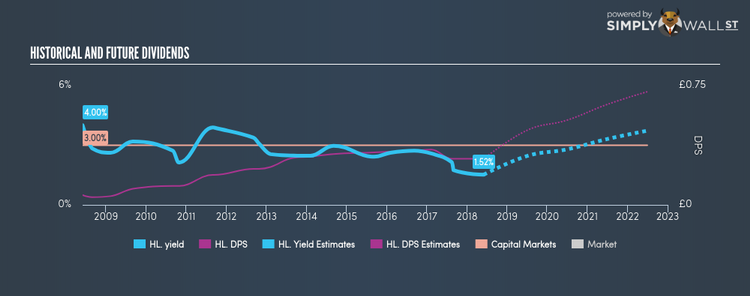What To Know Before Buying Hargreaves Lansdown plc (LON:HL.) For Its Dividend

Dividends can be underrated but they form a large part of investment returns, playing an important role in compounding returns in the long run. Over the past 10 years, Hargreaves Lansdown plc (LSE:HL.) has returned an average of 3.00% per year to shareholders in terms of dividend yield. Does Hargreaves Lansdown tick all the boxes of a great dividend stock? Below, I’ll take you through my analysis. View our latest analysis for Hargreaves Lansdown
5 checks you should use to assess a dividend stock
If you are a dividend investor, you should always assess these five key metrics:
Is its annual yield among the top 25% of dividend-paying companies?
Has its dividend been stable over the past (i.e. no missed payments or significant payout cuts)?
Has dividend per share amount increased over the past?
Is it able to pay the current rate of dividends from its earnings?
Will it have the ability to keep paying its dividends going forward?
Does Hargreaves Lansdown pass our checks?
Hargreaves Lansdown has a trailing twelve-month payout ratio of 64.51%, meaning the dividend is sufficiently covered by earnings. In the near future, analysts are predicting a higher payout ratio of 82.15%, leading to a dividend yield of 2.56%. Furthermore, EPS should increase to £0.54. The higher payout forecasted, along with higher earnings, should lead to greater dividend income for investors moving forward. Reliablity is an important factor for dividend stocks, particularly for income investors who want a strong track record of payment and a positive outlook for future payout. Although HL.’s per share payments have increased in the past 10 years, it has not been a completely smooth ride. Investors have seen reductions in the dividend per share in the past, although, it has picked up again. Compared to its peers, Hargreaves Lansdown produces a yield of 1.52%, which is on the low-side for Capital Markets stocks.
Next Steps:
If you are building an income portfolio, then Hargreaves Lansdown is a complicated choice since it has some positive aspects as well as negative ones. However, if you are not strictly just a dividend investor, the stock could still offer some interesting investment opportunities. Given that this is purely a dividend analysis, I recommend taking sufficient time to understand its core business and determine whether the company and its investment properties suit your overall goals. I’ve put together three essential aspects you should look at:
Future Outlook: What are well-informed industry analysts predicting for HL.’s future growth? Take a look at our free research report of analyst consensus for HL.’s outlook.
Valuation: What is HL. worth today? Even if the stock is a cash cow, it’s not worth an infinite price. The intrinsic value infographic in our free research report helps visualize whether HL. is currently mispriced by the market.
Dividend Rockstars: Are there better dividend payers with stronger fundamentals out there? Check out our free list of these great stocks here.
To help readers see pass the short term volatility of the financial market, we aim to bring you a long-term focused research analysis purely driven by fundamental data. Note that our analysis does not factor in the latest price sensitive company announcements.
The author is an independent contributor and at the time of publication had no position in the stocks mentioned.

